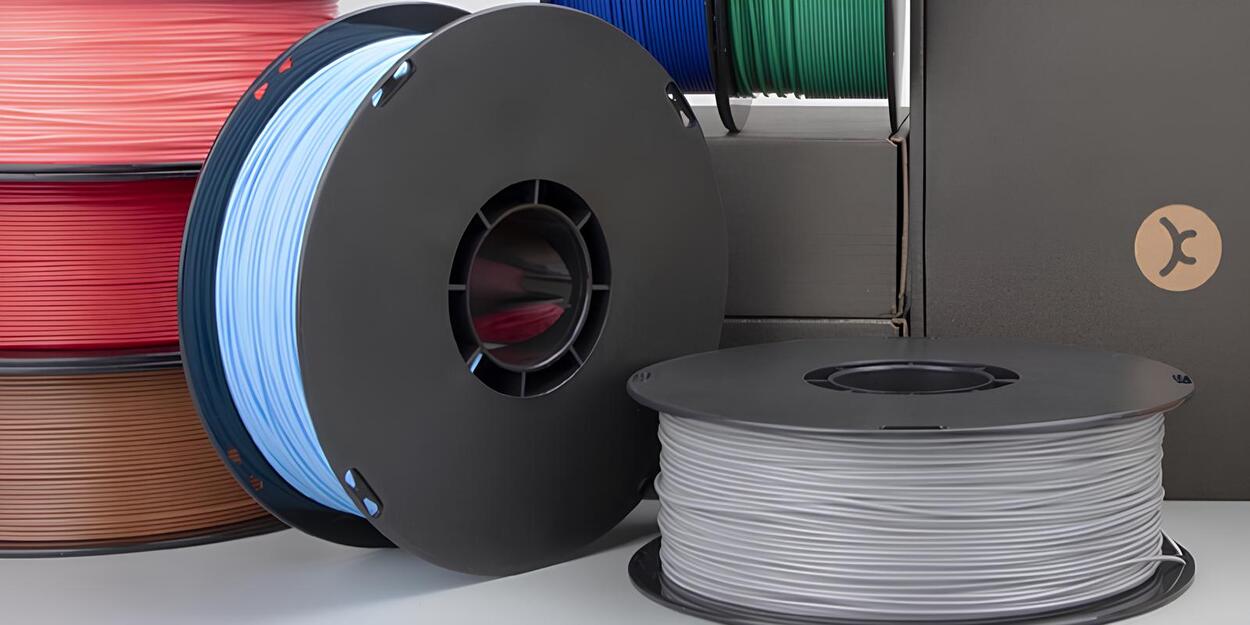Banner Image Courtesy of Kexcelled
Polyethylene Terephthalate Glycol (PETG) has surged in popularity as a 3D printing filament, bridging the gap between the ease of PLA and the robustness of ABS. Hobbyists appreciate its glossy finish and durability, while professionals leverage its chemical resistance and mechanical strength for functional prototypes and end-use parts.
What Is PETG Filament?
PETG stands for Polyethylene Terephthalate Glycol-modified, a copolyester that incorporates glycol during polymerization to enhance durability and reduce brittleness.
Unlike PLA (polylactic acid), which is bio-based and compostable, PETG is derived from petroleum but offers a superior balance of strength and printability. Chemically, PETG shares the backbone of PET (used in water bottles) but resists crystallization, making it ideal for transparent or translucent prints with minimal warping. Its modified glycols give PETG better layer adhesion and impact resistance compared to standard PET, positioning it as a versatile choice for both decorative and structural 3D printed parts.
Key Material Properties
Strength & Durability
1. Tensile strength around 50–55 MPa and excellent impact resistance.
2. Far less brittle than PLA; resists cracking under load.
Flexibility
Moderate elongation at break (around 10–20%), allowing slight flex without deformation.
Thermal Behavior
1. Glass transition temperature ~80 °C; melting point ~230–260 °C.
2. Less prone to warping, but benefits from a heated bed to maintain dimensional accuracy.
Moisture Sensitivity
1. Hygroscopic: absorbs moisture over time, which can cause bubbling and poor surface finish if not dried properly.
2. Store in sealed, desiccant-filled containers; dry at 65 °C for 4–6 hours if filament becomes damp.
Chemical Resistance & Safety
1. Resistant to many chemicals and solvents.
2. FDA-compliant food-safe variants exist—ideal for kitchen gadgets and containers (verify manufacturer certification).
Pros and Cons of 3D Printing PETG Filament
|
Pros |
Cons |
|
Excellent layer adhesion |
Can string or ooze if settings aren’t dialed in |
|
High impact resistance and toughness |
Slightly more challenging to print than PLA |
|
Low warping and shrinkage |
Requires a well-leveled bed and enclosure for best results |
|
Good chemical and weather resistance |
Hygroscopic—must be stored and dried properly |
|
Glossy, translucent aesthetic options |
Cooling must be balanced to avoid layer separation |
Recommended Printer Settings
1. Nozzle Temperature: 235–250 °C. Start at 240 °C; adjust ±5 °C to optimize layer adhesion and surface finish.
2. Bed Temperature: 70–80 °C. Use PEI sheets or blue painter’s tape for adhesion; a glue stick can improve hold.
3. Print Speed: 30–50 mm/s. Slower speeds help reduce stringing; speed up infill if you’re confident in your cooling.
4. Retraction: Distance: 1–3 mm (direct drive) or 4–6 mm (Bowden). Speed: 25–45 mm/s; too fast can grind filament, too slow leads to stringing.
5. Cooling Fan: 30–50%. PETG benefits from moderate cooling; too much can weaken layer bonds, and too little increases blobbing.
6. Layer Height: 0.1–0.3 mm. Fine layers for detail; thicker layers for strength and faster build time.
7. Enclosure: Optional but helps maintain stable ambient temperature, especially for lengthy prints.
8. Z-Offset / First Layer: Calibrate to a slightly squished first layer for optimal bed adhesion without over-flattening.
Top Applications for PETG 3D Prints
Functional Prototypes & End-Use Parts
Gears, brackets, mechanical joints, housings—any component requiring toughness and impact resistance.
Food-Safe Containers & Kitchen Tools
Cups, bowls, utensils—using certified food-grade PETG for items contacting food or beverage.
Outdoor & Weather-Resistant Projects
Garden tools, drone frames, or enclosures exposed to UV and moisture (consider UV-resistant PETG blends).
Lighting Fixtures & Diffusers
Translucent prints offer smooth light diffusion for lampshades and LED covers.
Educational Models & Makerspace Projects
Durable enough for repeated handling in classroom or workshop environments.
Try Hi3DP FDM 3D Printing Service
Looking to skip the calibration and dial-in work? Here’s why thousands of customers trust Hi3DP’s FDM 3D printing service :
Instant Quotes & Rapid Turnaround: Upload your STL, choose PETG, and get pricing within minutes—shipped in as little as 2 business days.
Quality Assurance: Parts undergo dimensional inspection and strength testing to meet your specifications.
Custom Finishes & Assembly: Post-processing options include sanding, painting, and chemical smoothing. Assembly and kitting services are available for multi-part projects.
Global Shipping & Support: Whether you’re in North America, Europe, or Asia, we deliver reliable quality worldwide.
FAQs
Q: Is PETG filament food safe?
A: Only if it’s certified food-grade by the manufacturer. Always verify FDA or EU approvals before using PETG for food-contact applications.
Q: Can I print PETG without a heated bed?
A: It’s possible on glass with adhesive aids (e.g., glue stick), but a heated bed (70–80 °C) greatly improves first-layer adhesion and reduces warping.
Q: How should I store PETG to prevent moisture issues?
A: Keep spools in airtight containers with silica gel desiccants. If prints show bubbles or poor layer bonding, dry the filament at 65 °C for 4–6 hours.
Q: What’s the best way to reduce stringing in PETG prints?
A: Optimize retraction (distance & speed), lower nozzle temperature in 5 °C increments, and enable combing or coasting settings in your slicer.
Q: How does PETG compare to PLA and ABS?
A: PETG is tougher than PLA and less prone to warping than ABS. It combines PLA’s printability with ABS’s strength, making it a balanced choice for many projects.














